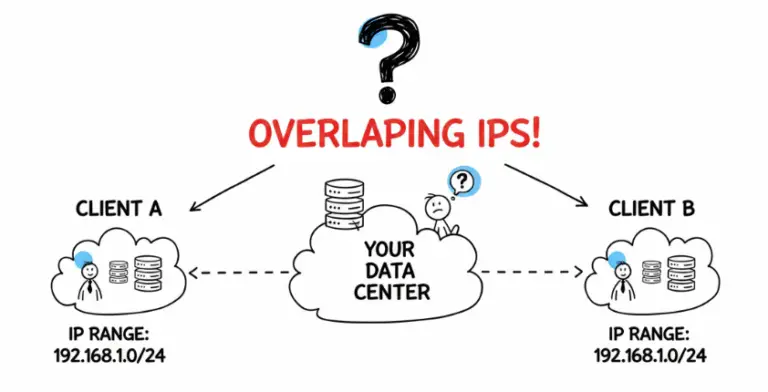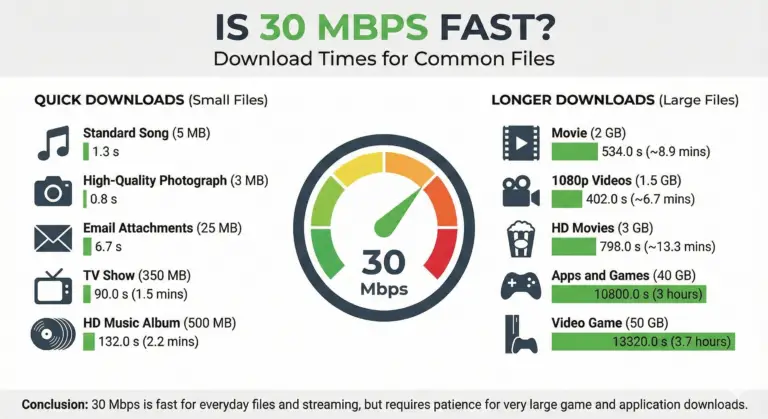Virtualization technologies, like QEMU and KVM, are both utilized to run VNFs in OpenStack or experiment with virtual environments in GNS3 or EVE-NG. However, understanding the key differences between QEMU vs. KVM is essential.
Simply put, QEMU is a type 2 hypervisor known for its ability to emulate various hardware platforms and CPU architectures, making it ideal for development and testing environments. On the other hand, KVM (Kernel-based Virtual Machine) operates as a type 1 hypervisor, offering hardware-assisted virtualization for Linux, leading to superior performance in production environments.
While both serve as powerful tools for virtualization, their optimal use cases differ significantly. Stay tuned as we delve deeper into how these technologies compare and how to leverage their strengths effectively.
KVM vs. Qemu
Here’s a detailed comparison table for QEMU vs KVM:
| Feature | QEMU | KVM |
|---|---|---|
| Type | Type 2 Hypervisor (runs on a host OS) | Type 1 Hypervisor (runs directly on hardware) |
| Hardware virtualization | Emulates hardware in software (slow) | Utilizes hardware-assisted virtualization (faster) |
| CPU emulation | Can emulate different CPU architectures (e.g., ARM on x86 or PPC on ARM) | Requires CPU with virtualization extensions (e.g., Intel VT or AMD-V) |
| Integration | Can run standalone or in conjunction with KVM for better performance | Requires a user-space component, often QEMU, to provide the virtual hardware emulation |
| Performance | Slower due to software-based emulation | Faster due to hardware-assisted virtualization |
| Host OS support | Works on multiple host operating systems | Limited to Linux-based host operating systems |
| Application | Ideal for testing and development environments where CPU architecture emulation is required | Ideal for production environments where performance is critical |
Please note that QEMU and KVM are often used together, with QEMU providing the virtual hardware emulation and KVM providing the hardware-assisted virtualization to significantly improve performance.
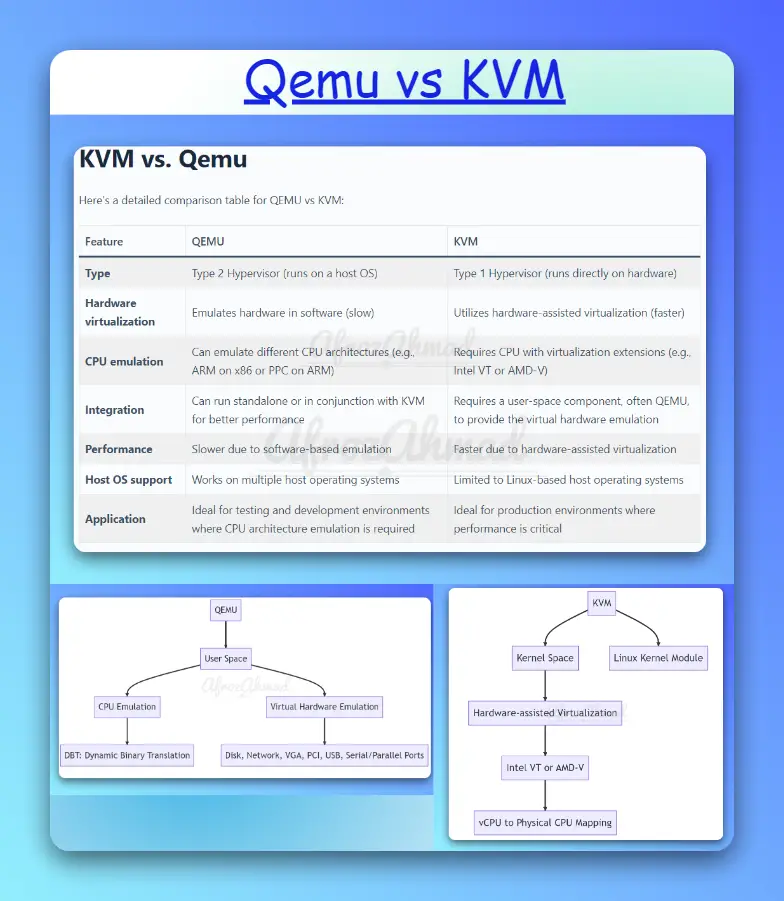
Understanding Virtualization: The Basics
Before we dive into the intricacies of QEMU vs. KVM, it’s essential to understand the basics of virtualization. Virtualization is the process of creating a virtual version of a resource, such as a server, storage device, or network, which can be managed and allocated efficiently. This technology allows multiple virtual machines (VMs) to run on a single physical host, providing significant advantages in terms of cost, scalability, and flexibility.
Make sure you read the below posts to grasp more knowledge on virtualization.
Hypervisors: The Heart of Virtualization
Hypervisors are the core components of virtualization solutions, as they enable the creation and management of virtual machines. There are two types of hypervisors:
- Type 1 (Bare Metal): These hypervisors run directly on the host’s hardware, offering better performance and resource utilization.
- Type 2 (Hosted): These hypervisors run on a host operating system and provide virtualization functionality through software emulation.
With this foundational knowledge, let’s explore QEMU and KVM in detail.
QEMU: A Flexible Type 2 Hypervisor
QEMU, the Quick Emulator, is a hosted hypervisor that achieves hardware virtualization through software emulation. It offers an extensive array of virtual hardware components, including disk, network, VGA, PCI, USB, serial/parallel ports, and more.
One of QEMU’s most significant advantages is its ability to emulate different CPU architectures using dynamic binary translation (DBT). This feature enables code written for one processor to be executed on another, such as running ARM code on x86 hardware.
While QEMU is highly flexible, it is also slower compared to hardware-assisted virtualization solutions due to its reliance on software emulation. This is where KVM comes into play.
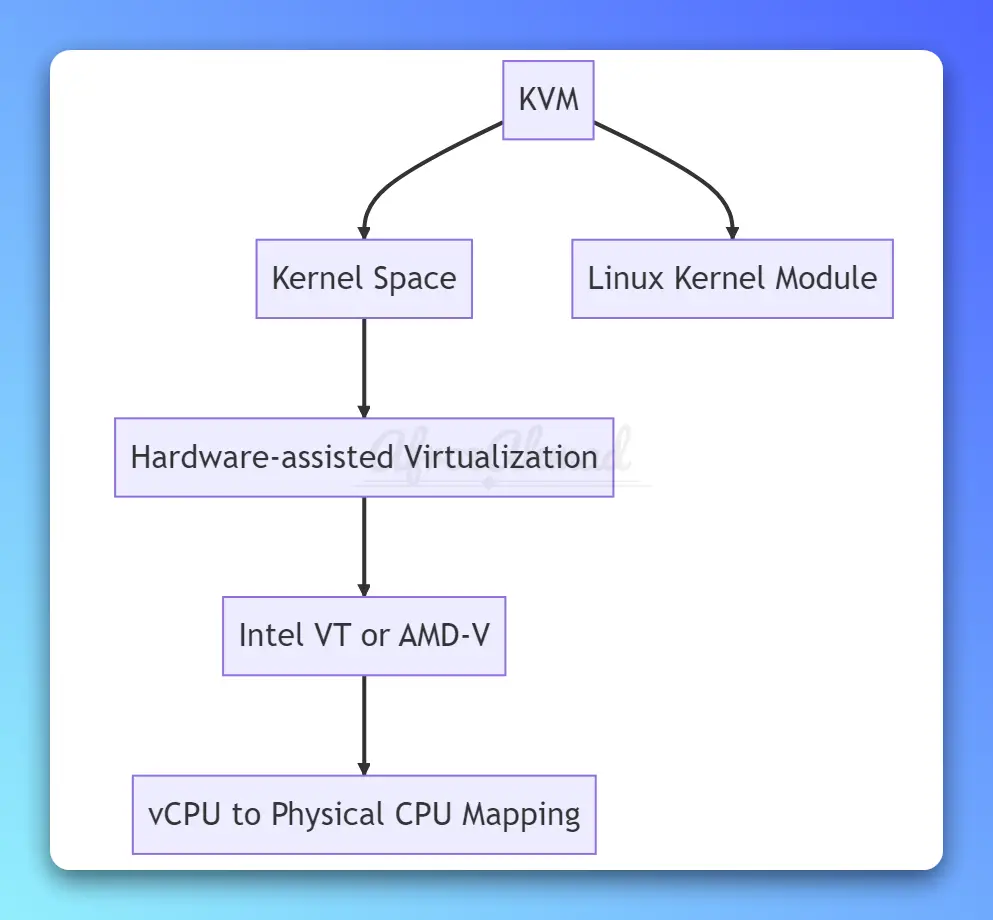
This diagram represents the QEMU virtualization technology. QEMU operates in user space and provides CPU emulation through dynamic binary translation (DBT). It also emulates virtual hardware components, such as disk, network, VGA, PCI, USB, serial, and parallel ports.
KVM: A High-Performance Type 1 Hypervisor
KVM or Kernel-based Virtual Machine is a type-1 hypervisor integrated into the Linux kernel as a module. It provides a full virtualization solution for Linux on x86 hardware equipped with virtualization extensions, such as Intel VT or AMD-V.
Full virtualization refers to the process of emulating a virtual CPU (vCPU) by the hypervisor, which translates instructions intended for the vCPU to the physical CPU. This translation causes a considerable performance impact.
Modern processors with virtualization extensions, like Intel VT-x and AMD-V, allow a slice of the physical CPU to be directly mapped to the vCPU, enabling instructions intended for the vCPU to be executed directly on the physical CPU slice. This hardware-assisted virtualization significantly improves performance.
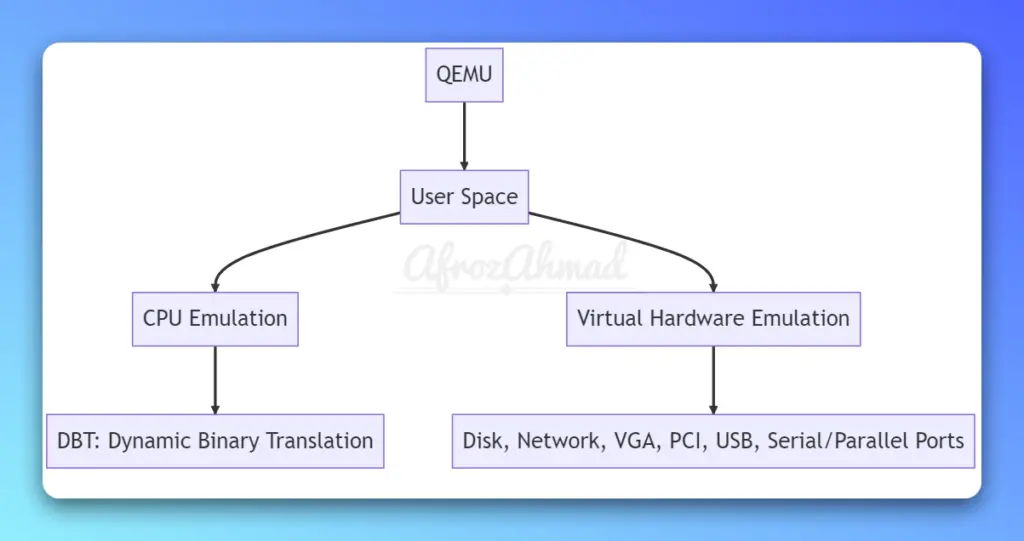
This diagram represents the KVM virtualization technology. KVM operates as a Linux kernel module within kernel space, providing hardware-assisted virtualization using Intel VT or AMD-V. This allows for efficient mapping between virtual CPUs (vCPUs) and physical CPUs.
The Synergy between QEMU and KVM
Although QEMU can function independently, its software emulation causes it to be slower than desired. To address this issue, QEMU can utilize KVM as an accelerator, leveraging the hardware virtualization features provided by modern processors.
A Historical Perspective
The confusion between QEMU and KVM can be traced back to their intertwined history. Initially, KVM was a fork of QEMU, known as qemu-kvm. However, this fork has been discontinued and merged into QEMU’s mainline code. As a result, the kernel component of KVM is now included in the mainline Linux kernel (since version 2.6.20), and the userspace component is integrated into QEMU (since version 1.3).
Making the Right Choice: QEMU, KVM, or Both?
When selecting a virtualization solution, it’s crucial to consider the specific requirements of your organization. Here are some factors to keep in mind:
- Performance: If high performance is a priority, KVM is the better choice due to its hardware-assisted virtualization capabilities. However, if flexibility is more critical, QEMU’s ability to emulate various CPU architectures might be more appealing.
- Hardware Support: KVM requires hardware with virtualization extensions (Intel VT or AMD-V). If your hardware does not support these extensions, QEMU can still provide virtualization through software emulation, albeit with reduced performance.
- Operating System: KVM is tightly integrated with the Linux kernel, making it an ideal choice for Linux-based environments. On the other hand, QEMU supports a broader range of host operating systems, including Windows and macOS.
In many cases, using QEMU in conjunction with KVM can provide the best of both worlds: the flexibility of QEMU’s hardware emulation and the performance boost of KVM’s hardware-assisted virtualization.
Conclusion
In summary, QEMU is a type 2 hypervisor that runs within user space and performs virtual hardware emulation. On the other hand, KVM is a type 1 hypervisor that runs in kernel space, enabling user space programs to access the hardware virtualization features of various processors.
Understanding the differences between QEMU and KVM, as well as their unique strengths, is crucial for choosing the right virtualization solution for your organization. While QEMU offers flexibility through its software emulation capabilities, KVM provides superior performance through hardware-assisted virtualization.
By leveraging the synergistic relationship between QEMU and KVM, organizations can achieve optimal performance and flexibility in their virtual environments. With a clear understanding of these technologies, you can make well-informed decisions that meet your organization’s specific virtualization needs.
- MikroTik CRS305-1G-4S+ Review: The Ultimate Budget SFP+ Switch Guide - December 25, 2025
- 10 Best Network Switches for Home Networks in 2026 (Top Picks) - December 24, 2025
- 7 Best Budget Routers For Small Business Networks (Under $200) - December 22, 2025

